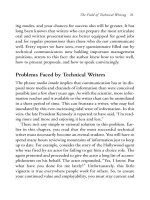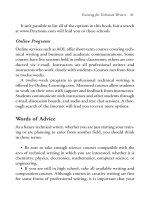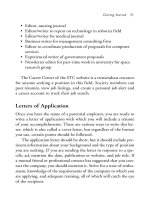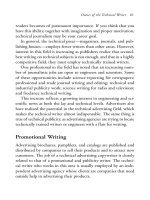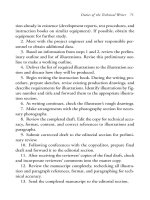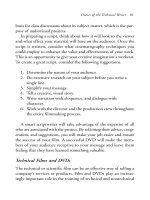OPPORTUNITIES IN VETERINARY MEDICINE CAREERS Robert E. Swope pdf
Bạn đang xem bản rút gọn của tài liệu. Xem và tải ngay bản đầy đủ của tài liệu tại đây (389.9 KB, 161 trang )
This page intentionally left blank.
VGM Opportunities Series
OPPORTUNITIES IN
VETERINARY
MEDICINE CAREERS
Robert E. Swope
Revised by
Julie Rigby
Foreword by
Leonard F. Seda, D.V.M.
President
American Veterinary Medical Association
VGM Career Books
Copyright © 2001 by The McGraw-Hill Companies. All rights reserved. Manufactured in the United
States of America. Except as permitted under the United States Copyright Act of 1976, no part of this
publication may be reproduced or distributed in any form or by any means, or stored in a database
or retrieval system, without the prior written permission of the publisher.
0-07-139205-X
The material in this eBook also appears in the print version of this title: 0-658-01054-9 HC
All trademarks are trademarks of their respective owners. Rather than put a trademark symbol after
every occurrence of a trademarked name, we use names in an editorial fashion only, and to the benefit
of the trademark owner, with no intention of infringement of the trademark. Where such designations
appear in this book, they have been printed with initial caps.
McGraw-Hill eBooks are available at special quantity discounts to use as premiums and sales pro-
motions, or for use in corporate training programs. For more information, please contact George
Hoare, Special Sales, at or (212) 904-4069.
TERMS OF USE
This is a copyrighted work and The McGraw-Hill Companies, Inc. (“McGraw-Hill”) and its licensors
reserve all rights in and to the work. Use of this work is subject to these terms. Except as permitted
under the Copyright Act of 1976 and the right to store and retrieve one copy of the work, you may not
decompile, disassemble, reverse engineer, reproduce, modify, create derivative works based upon,
transmit, distribute, disseminate, sell, publish or sublicense the work or any part of it without
McGraw-Hill’s prior consent. You may use the work for your own noncommercial and personal use;
any other use of the work is strictly prohibited. Your right to use the work may be terminated if you
fail to comply with these terms.
THE WORK IS PROVIDED “AS IS”. McGRAW-HILLAND ITS LICENSORS MAKE NO GUAR-
ANTEES OR WARRANTIES AS TO THE ACCURACY, ADEQUACY OR COMPLETENESS OF
OR RESULTS TO BE OBTAINED FROM USING THE WORK, INCLUDING ANY INFORMA-
TION THAT CAN BE ACCESSED THROUGH THE WORK VIA HYPERLINK OR OTHERWISE,
AND EXPRESSLY DISCLAIM ANY WARRANTY, EXPRESS OR IMPLIED, INCLUDING BUT
NOT LIMITED TO IMPLIED WARRANTIES OF MERCHANTABILITY OR FITNESS FOR A
PARTICULAR PURPOSE. McGraw-Hill and its licensors do not warrant or guarantee that the func-
tions contained in the work will meet your requirements or that its operation will be uninterrupted or
error free. Neither McGraw-Hill nor its licensors shall be liable to you or anyone else for any inac-
curacy, error or omission, regardless of cause, in the work or for any damages resulting therefrom.
McGraw-Hill has no responsibility for the content of any information accessed through the work.
Under no circumstances shall McGraw-Hill and/or its licensors be liable for any indirect, incidental,
special, punitive, consequential or similar damages that result from the use of or inability to use the
work, even if any of them has been advised of the possibility of such damages. This limitation of lia-
bility shall apply to any claim or cause whatsoever whether such claim or cause arises in contract, tort
or otherwise.
DOI: 10.1036/007139205X
abc
0-658-01055-7 PB.
iii
CONTENTS
About the Author . . . . . . . . . . . . . . . . . . . . . . . . . . . . . . . vi
Foreword . . . . . . . . . . . . . . . . . . . . . . . . . . . . . . . . . . . . . vii
1. The World of Veterinary Medicine . . . . . . . . . . . . . .1
Veterinary college enrollment. Working with veterinarians.
Expanding opportunities. A broader picture. Contributions to
human health.
2. History of Veterinary Medicine . . . . . . . . . . . . . . . .10
Ancient civilizations. Premodern history. The eighteenth and
nineteenth centuries. The twentieth century.
3. Preparing for Your Future As a Veterinarian. . . . .29
Observing veterinarians at work. Personal assessment. High
school preparation. College. Designing a preveterinary
curriculum. Veterinary medical education. Professional
standards. Gaining admission to a veterinary college. Criteria
used for the selection of applicants. Veterinary Medical
College Application Service. Financing a veterinary
education. Scholarships and loans. Continuing education and
graduate studies.
McGraw-Hill's Terms of Use
iv Opportunities in Veterinary Medicine Careers
4. The Veterinarian in the Twenty-First Century . . . 51
General practitioners. Contract practice. Partnership practice.
Group practice. Specialty practices. The veterinary hospital.
Small-animal practice. Zoo veterinarians. Expected income.
A license to practice. Foreign veterinary graduates.
5. Veterinarians in Public Service . . . . . . . . . . . . . . . . 70
United States Department of Agriculture. U.S. Public Health
Service. Affiliated federal agencies. Communicable disease
research. Educational requirements. United States Food and
Drug Administration. Public service at the state and local
levels. Veterinarians as specialists. Veterinarians in world
service. Providing assistance abroad. Agency for
International Development. Role of the USDA. International
cooperation. Involvement in the Americas. The Peace Corps.
6. Veterinarians in Industry. . . . . . . . . . . . . . . . . . . . . 90
Veterinarians in the drug industry. Veterinarians in the food
industry. Other industry opportunities.
7. Institutional Teaching and Research . . . . . . . . . . . 94
Rewards of academic work. Research agencies and
categories. Link between human and animal health. The
extension veterinarian. Laboratory animal medicine.
Scientific organizations. AVMA positions on animals used in
research and teaching.
8. Veterinarians in the Military . . . . . . . . . . . . . . . . . 106
History of the Veterinary Corps. VETCOM. Disease
prevention. Dogs and horses. 91T training.
Contents v
9. Related Careers: Veterinary Technicians
and Other Paramedical Personnel . . . . . . . . . . . . .111
Education and employment. Curriculum and licensing
requirements. Salaries and career tracks.
10. Veterinary Organizations . . . . . . . . . . . . . . . . . . . .115
The American Veterinary Medical Association. U.S. Animal
Health Association. Other organizations.
11. Future Trends in Veterinary Medicine . . . . . . . . .120
Appendix A: Colleges of Veterinary
Medicine . . . . . . . . . . . . . . . . . . . . . . . . . . . . . . . . . .122
U.S. schools. Canadian schools.
Appendix B: Programs in Veterinary
Technology . . . . . . . . . . . . . . . . . . . . . . . . . . . . . . . .127
Appendix C: Veterinary Specialty Organizations. . . .140
Appendix D: Veterinary Publications . . . . . . . . . . . . .143
Glossary . . . . . . . . . . . . . . . . . . . . . . . . . . . . . . . . . . . . .145
Selected Bibliography . . . . . . . . . . . . . . . . . . . . . . . . . .150
vi
ABOUT THE AUTHOR
Robert E. Swope actively participated in student affairs
for more than two decades, serving as an academic advisor
for undergraduate preveterinary students and counseling
hundreds of students in the biological sciences. Formerly a
Professor of Veterinary Science and Assistant Dean for Res-
ident Education at Pennsylvania State University, he also
conducted research on bovine diseases.
Fully acquainted with the breadth and depth of contempo-
rary veterinary science, Dr. Swope served as a veterinary ad-
visor on assignment in India and Chile on three occasions. A
member of the American Veterinary Medical Association
and the United States Animal Health Association, the author
also conducted research and diagnostic work at the Univer-
sity of Maryland and served with the U.S. Army Veterinary
Corps. Dr. Swope received his V.M.D. (Doctor of Veterinary
Medicine) from the University of Pennsylvania.
Julie Rigby is a freelance writer living in Vermont.
vii
FOREWORD
A career in veterinary medicine offers opportunities in a
wide variety of professional areas, including public health,
care of companion and food animals, government service,
research, and many others. A large percentage of veterinari-
ans also work in private clinical practice. No matter what
area of expertise, however, the link that bonds all veterinari-
ans is their ability and aptitude for problem solving and the
fact that they all thoroughly enjoy doing it.
Veterinarians want to know why. As scientists they pos-
sess an inquisitive nature, and as clinicians they want to find
practical applications for their knowledge.
The unique challenges of a medical/scientific career are
now being augmented with computer technology, which
helps veterinarians develop and manage more information.
These advancements present enormous opportunities for ap-
plications in the diagnosis and treatment of animals as well
as human members in the family. The ability to communi-
cate with both the patient and the owner or guardian is ex-
tremely important in the veterinary profession.
viii Opportunities in Veterinary Medicine Careers
Veterinarians must possess a love of animals, and they
need to enjoy and have respect for human relationships. Vet-
erinary medicine is a diverse profession that provides its
members with not only the means to earn a living, but a life-
time of fulfillment and personal growth. It is my sincere
wish that your career choice provides you with the opportu-
nity for developing lifelong friendships and a sense of both
personal and professional satisfaction and success.
Leonard F. Seda, D.V.M.
President
American Veterinary Medical Association
1
CHAPTER 1
THE WORLD OF
VETERINARY MEDICINE
If you decide to become a veterinary surgeon you
will never grow rich, but you will have a life of end-
less interest and variety.
—James Herriot
Do you enjoy being with animals? Are you the kind of
person who volunteers to walk the dog, groom the horse, or
even handle the classroom snake or rat? Or maybe you are
intrigued by news reports of the work of veterinarians in the
field of infectious diseases that affect wild animals, live-
stock, and even humans. Perhaps you have had an opportu-
nity to observe a veterinarian at work and have decided to
pursue a career dedicated to promoting the health of a wide
range of domesticated animals.
If you feel comfortable working with animals, that’s a
good start for a future in veterinary medicine. But it is only a
start. Veterinary medicine belongs to the field of medical sci-
ence, and as such it requires years of education before one
can assume the mantle of a Doctor of Veterinary Medicine.
McGraw-Hill's Terms of Use
2 Opportunities in Veterinary Medicine Careers
Veterinarians put in long hours, often dealing with very dif-
ficult and complex issues. A veterinarian may spend his or
her work hours tromping around in frozen mud taking care
of dairy cows or may be called upon to euthanize a badly in-
jured or critically ill pet dog or cat.
If even the worst-case scenarios don’t scare you off, con-
gratulations. The world of veterinary medicine is above all
an extremely rewarding field, one that provides high job sat-
isfaction and interesting challenges. Those who enter veteri-
nary school belong to a select group of high-achieving
students, individuals who have been encouraged by their
teachers and guidance counselors to pursue one of the most
varied scientific careers. Your fellow veterinary candidates
all have a strong background in the biological sciences and a
consuming desire to learn more about the various issues af-
fecting the health of animals.
Opportunities abound for dedicated students of veterinary
medicine. Veterinarians are employed by a wide range of or-
ganizations, and they care for an equally vast number of spe-
cies—from the hippopotamus in the local zoo to the canine
forces of the U.S. military, to the elite racehorses worth mil-
lions of dollars—not to mention countless dogs, cats, rab-
bits, birds, and other household pets. Veterinarians are also
exploring the frontiers of research. For example, in 1999
veterinarians led the investigation into the causes of an out-
break of West Nile virus in New York state, tracing the cases
of deadly human encephalitis to a rare virus infecting birds.
Other ongoing research includes work on cancer, epilepsy,
The World of Veterinary Medicine 3
leukemia, and other diseases in animals and people; explora-
tions in genetic engineering and cloning; and new techniques
for surgical intervention for injured animals. Veterinarians
are also intimately involved in working to increase the pro-
ductivity of domesticated animals to meet the world’s rising
demand for food, as well as helping to preserve species that
are endangered by the human population explosion and the
destruction of the animals’ natural habitats.
Is veterinary medicine for you? The hours are long, and no
doubt there is more money to be made in other lines of work.
And maybe it is not always as romantic as the wonderful
memoirs of James Herriot, author of
All Creatures Great and
Small
and other books about his life as a veterinarian in rural
England. Yet ask a practicing veterinarian what he or she
likes most about the profession, and you are likely to hear
that the appeal of veterinary medicine lies in its variety, the
opportunities for lifelong learning, and the satisfaction that
can come only from applying one’s self to a challenging task.
VETERINARY COLLEGE ENROLLMENT
The great strides made in veterinary medicine at the close
of the twentieth century created more opportunities for fu-
ture veterinarians to receive a cutting-edge, challenging edu-
cation. In the last twenty years the number of excellent
veterinary medical colleges in the United States and Canada
has grown to twenty-seven.
4 Opportunities in Veterinary Medicine Careers
Another important development was the entrance of
women into the ranks of veterinarians. Where only a few de-
cades ago it was virtually unheard of for women to become
veterinarians, by the end of the twentieth century more
women than men were studying veterinary medicine in the
United States. The trend’s growth was extremely rapid. In
1970 women made up only 10 percent of all students en-
rolled in veterinary colleges. By 1999, however, 70 percent
of all veterinary students were women. That year, there were
9,055 veterinary students in the United States alone; of
these, 2,759 were men and 6,296 were women.
The increasing number of female veterinary students is ul-
timately changing the face of veterinary practice. In 1991
there were 37,200 men and 11,500 women working as veter-
inarians in the United States. By 1999, as some of the older
veterinarians retired and more recent graduates entered the
field, women made up 34 percent of the 45,200 veterinarians
in private practice and 43 percent of the 10,180 employed by
government organizations and corporations!
While the situation for women who wish to become veter-
inarians has improved dramatically, there are still gains to be
made in opportunities for minority students. According to the
American Association of Veterinary Medical Colleges, there
were a total of 6,695 applicants to veterinary schools in 1999.
Of these, 5,648 were identified as Caucasian. Only 135 appli-
cants were identified as African-American, 226 as Hispanic,
55 as Native American, 204 as Asian, and another 88 as
“other.” In order to promote greater diversity in the field, vet-
The World of Veterinary Medicine 5
erinary educators are working to encourage more minority
students to consider this exciting and rewarding profession.
WORKING WITH VETERINARIANS
Suppose you are interested in working with animals, but
do not wish to pursue the rigorous and time-consuming
course of study required to become a veterinarian. The re-
lated field of veterinary technology is a great option open to
those who want to work with animals under the supervision
of a veterinarian. This career path does not require the clini-
cal medical knowledge that veterinarians must have, and
training as a veterinary technician can usually be completed
in a two-year program after high school. Veterinary techni-
cians are an integral part of any veterinary practice, perform-
ing medical tests on animals, preparing and delivering
vaccines and other injections, and assisting with surgical pro-
cedures. Opportunities in this rapidly growing profession are
found throughout the country, as well as in the military. (See
Appendix B for a list of veterinary technology programs.)
EXPANDING OPPORTUNITIES
Ve terinarians have always been involved in much more
than the routine care of domestic animals. Yet by the begin-
ning of the twenty-first century, the role of veterinarians has
grown to encompass even more challenges and opportunities.
6 Opportunities in Veterinary Medicine Careers
Veterinarians play an increasingly critical role in agricul-
tural production, ensuring that the food on our tables comes
from healthy animals. They monitor the humane transporta-
tion and slaughter of animals and check to see that animals
used for food both here and abroad are disease-free.
Approximately 50 percent of our foodstuffs are derived
from animals in the form of meat and dairy products—
everything ranging from cattle and pork to fish, eggs, milk, and
cheese. In the last ten years, in fact, the range of animal prod-
ucts available in the United States has expanded to include
free-range bison and eggs from emus. By the beginning of the
twenty-first century, the number of people on earth passed the
six billion mark. Faced with this population explosion, agricul-
ture at home and abroad must produce more livestock to meet
the growing need for food and other animal products, includ-
ing the materials from animals that we use to manufacture
clothing. Livestock producers rely on veterinarians to increase
their productivity; the success or failure of a livestock opera-
tion may often hinge on the effectiveness of a veterinarian.
Similarly, consumers count on veterinarians to ensure that the
animals used in livestock operations are treated humanely and
with an eye toward creating healthy food products.
A BROADER PICTURE
American veterinarians have made historic contributions
to the advancement of both agriculture and public health.
The World of Veterinary Medicine 7
They also have a tradition of sharing new knowledge, prac-
tices, and technology with people beyond our national bor-
ders, providing assistance and advice to underdeveloped
nations. These nations are striving to implement the same
standards for livestock production and human health that ex-
ist in the United States. Veterinary medicine is, therefore,
playing a key role in such development.
Students exploring careers in veterinary medicine are of-
ten unaware of the tremendous challenges and opportunities
in this field. People generally acquire an image of veterinar-
ians through contact with their local veterinarian. For the ur-
ban youth, this contact is generally limited to small-animal
practitioners, who constitute about half of the veterinarians
in this country. While the percentage of small-animal practi-
tioners (the dog and cat doctors) is growing, there are other
veterinarians who lead exciting professional lives, some-
times working overseas with quite different animal popula-
tions, or in the United States with large or exotic animals.
Currently, there are almost 70,000 veterinarians in the
United States and Canada. A total of twenty-seven veteri-
nary schools and colleges enrolled more than 8,500 potential
veterinarians in 1999. That same year, more than 2,000 stu-
dents received their doctoral degrees in veterinary medicine.
In economic terms, veterinary professionals oversee in ex-
cess of 200 million head of livestock that have an economic
value of well over $50 billion. Veterinarians are also respon-
sible for the health of more than 52 million dogs, at a cost of
about $128.77 per dog per year. In addition to the number of
8 Opportunities in Veterinary Medicine Careers
dogs, more than 59 million cats were examined by veterinar-
ians during 1999. The feline population is growing quite
quickly, and it is estimated that on average the medical ex-
penses per cat are about $81 per year. Bird ownership has
also grown in recent years, to more than 13 million birds in
1999. And veterinarians also treat the 4 million horses, 5.7
million rabbits and ferrets, 4.8 million rodents, and 3.5 mil-
lion reptiles we keep as pets!
CONTRIBUTIONS TO HUMAN HEALTH
Veterinary medicine plays a significant role in the human
health-care delivery system. Veterinarians’ activities are of-
ten directly related to human beings. Veterinarians help
identify and prevent the outbreak and spread of animal dis-
eases, some of which, like rabies, can be transmitted to hu-
man beings. In addition, veterinarians are involved in food
protection, as well as the prevention and control of environ-
mental hazards. They also work on scientific research teams
on such projects as searching out new pharmaceuticals to
treat human heart disease. The military services have com-
missioned almost 450 veterinary officers to meet the food
inspection and other public health requirements of military
personnel and their families at home and abroad. In addition,
the military veterinarian may engage in new research fron-
tiers (see Chapter 8).
The World of Veterinary Medicine 9
The impact of environmental health hazards and food-
borne diseases upon human health has received increasing
attention. The control of the ingestion of toxic chemicals by
livestock has become a high priority objective as laboratory
research reveals their harmful effects on human health.
More than ever, there is a need for veterinarians who will be
able to deal with chemical contamination of the food chain.
As well, veterinarians are asked to provide expertise on
other public health concerns, such as the use of growth hor-
mones or bioengineering in livestock.
10
CHAPTER 2
HISTORY OF VETERINARY MEDICINE
The practice of veterinary medicine is one of the oldest
scientific skills developed by humans. During the Paleolithic
period prior to 8000
B
.
C
., our ancestors lived in a symbiotic
relationship with the wild animals around them, hunting
them for food, clothing, and other materials necessary for
survival. Animals had not yet been domesticated, except
possibly the dog. Survival depended on hunting a variety of
animals, which included sheep, cows, horses, and pigs. One
can easily imagine an ancient hunter caring for a dog that
helps him on his hunt, although no archaeological evidence
from this period has yet been discovered that suggests this
sort of prehistoric veterinary care.
The domestication of animals and the development of ag-
riculture began between 3000–2500
B
.
C
. The first farm ani-
mals to be domesticated were pigs, followed by sheep,
goats, horses, and oxen, which could be used for working in
the fields as well as for food. Although animals had always
had diseases in the wild, people had not lived in close
enough contact with them to recognize these diseases or for-
McGraw-Hill's Terms of Use
History of Veterinary Medicine 11
mulate remedies against them. But once the animals were
domesticated, ensuring their health became a real priority.
Not only were the animals important because they provided
the means of survival, they were also highly esteemed by
primitive people. For this reason, caring for them became a
matter of great concern to the early agriculturalists, although
there are no records telling the stories of the successes and
failures of the first veterinarians.
ANCIENT CIVILIZATIONS
Records from the early Egyptian, Babylonian, and Hindu
civilizations do provide some insights into ancient veteri-
nary knowledge. The evidence indicates that veterinary
medicine was given the same place in the society as human
medicine. Much of the veterinary record is interspersed with
information on human disease, an early sign of recognition
of the close correlation of human and animal medicine.
Egypt
Fascinating material has been preserved through the ages
that shows the early specialization of veterinary medicine. In
ancient Egypt, poultry, cat, and dog specialists offered spe-
cialized services, and those charged with the care of cattle
were especially burdened with responsibility, since the loss
of one of these sacred animals was more serious than that of
12 Opportunities in Veterinary Medicine Careers
a human life. Horses were also highly valued as military an-
imals, and specialists in the ills of horses were commis-
sioned for service in the Egyptian armies.
Because of its role as a center of commerce, Egypt was the
crossroads for the spread of animal disease. The Bible at the
time of Israelite captivity in Egypt describes plagues of lice,
flies, murrain (anthrax), boils, hail, and locusts that ravaged
both people and animals or destroyed their food supplies.
Moses was perhaps one of the first to establish regulations for
the isolation or quarantine of diseased animals—the basic
concept of preventive medicine.
The Code of Hammurabi provided for the legal regulation
of the practices of veterinary and human medicine. It deter-
mined the punishment for a veterinarian’s carelessness or ne-
glect; thus a veterinary surgeon who caused the death of an ox
or ass would be required to pay a quarter of the animal’s value
to its owner. In addition to a code of ethics, it required the re-
cording of diseases as they appeared to the practitioner and
established fixed fees for most services performed.
India
One must turn to India to find the most effectual and lasting
beginnings to the veterinary art. In the old Brahman Vedas,
dated about 1800
B
.
C
., veterinary specialization is described.
Ayurveda, the science of life, included veterinary medicine as
well as human medicine. In ancient agrarian India, a society
in which it was believed that people and animals traveled the
History of Veterinary Medicine 13
same road to destiny, animals were given a place of high es-
teem. During this period, cattle were the most prized posses-
sion, and the concept of reincarnation and the sacred position
of the cow arose from this close kinship between humans and
animals. Veterinary hospitals were established about 250
B
.
C
.,
and government edicts governed the practices of the Indian
veterinarian. These government-sponsored hospitals are much
in evidence in India today, and only in India are “gosadans” or
“old cow homes” provided for the care of the older animal.
The life of people in India in the second century
B
.
C
. was
closely bound together with animal life. The slaughter of an-
imals was prohibited, cruelty to animals was subject to se-
vere punishment, and animal owners were required to give
detailed accounts of diseases or deaths of animals. Selective
breeding, genetics, and the study of aging (geriatrics) were
carefully applied to animal as well as to human medicine.
Surgery and obstetrics were given foremost attention, and
some of the methods described are among those still in use
today. India maintained its place as the leading authority in
veterinary medicine until the tenth century
A
.
D
., when the art
and science of animal health fell into complete oblivion until
it was revived by the British some eight hundred years later.
Greece
The history of veterinary medicine now turns to Greece.
While ancient Greek medicine is well documented, begin-
ning with Aesculapius (1250
B
.
C
.), little is known of Greek
14 Opportunities in Veterinary Medicine Careers
veterinary medicine until the writings of Hippocrates in the
fourth century
B
.
C
. Under the guidance of Hippocrates, mod-
ern medicine was born, with the ethics, means of reporting,
and rational treatments that are familiar to us today. Hippo-
crates became a student of comparative anatomy and pathol-
ogy, recognizing some of the similarities between people
and animals.
Ancient Rome
Despite medical beginnings shrouded in mysticism, which
attributed events in human affairs to the actions of gods, the
Roman empire saw a growth in knowledge about the healing
arts. This era marks an important page in veterinary history.
“Professional” medicine reached Rome from Greece in the
third century
B
.
C
., but veterinary medicine did not receive full
attention until the first century
A
.
D
. Before then, Roman civili-
zation, possessing little regard for medicine itself, had, for
economic reasons, less interest in animals and their care.
As Roman appreciation of agriculture improved, however,
their attitude toward livestock was reversed. Animal hus-
bandry became a primary occupation among the agricultural
community, and techniques for animal isolation and quaran-
tine, sanitation, and concepts of disease transmission (partic-
ularly concerning the dreaded disease, rabies), were well
established. Purely Roman contributions to the field of veter-
inary medicine failed to develop, and since they lacked the
creativity to progress beyond their Greek inheritances, veter-
History of Veterinary Medicine 15
inary medicine soon fell, like the Empire itself, into a state of
decline. Only Galen, a Greek physician practicing in Rome,
can be counted as a member of this civilization who contrib-
uted measurably to veterinary progress. Galen was the origi-
nal anatomist and physiologist, and his recorded observations
were based on dissections of Roman military horses.
Byzantium
The Byzantine Empire, centered in Constantinople, but
nevertheless Greek in all respects, produced the voluminous
collections of veterinary writings, the
Hippiatrika,
repre-
senting a compilation of observations on the veterinary art
by actual practitioners of that era. One of the principal con-
tributors to the
Hippiatrika
was Apsyrtus, who along with
Vegetius, shares the title of “father of veterinary medicine.”
Apsyrtus was the leading veterinarian of his day and person-
ally described many of the medical and surgical problems
associated with the horse. Although Vegetius was not a vet-
erinarian, he provided an accurate presentation of the veteri-
nary art in his time. While basic conceptions still reverted to
those originating with the Greeks, Vegetius did add some of
his own original descriptions, expanding on Apsyrtus’s com-
mentaries by applying knowledge gained through experi-
ences with horses and cattle. When Vegetius’s pleas for the
cause of veterinary medicine went unheeded, the art of ani-
mal care virtually fell into oblivion for the next thousand
years.



